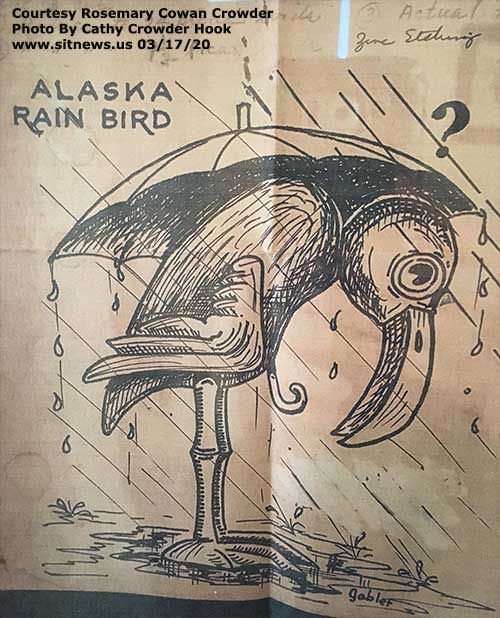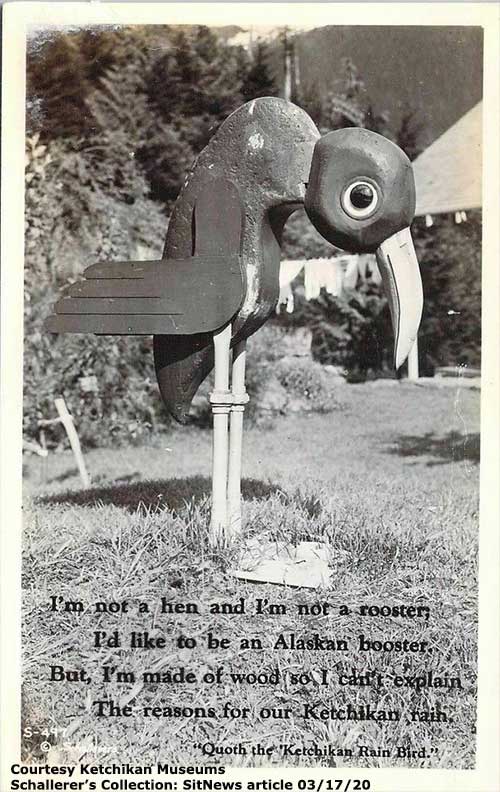THAT UBIQUITOUS KETCHIKAN RAINBIRD and HOW HE CAME TO BEBy LOUISE BRINCK HARRINGTON March 17, 2020
It was during a typical Ketchikan downpour, which had already lasted for two weeks, that the first bird emerged from a small piece of wood in a downtown Ketchikan restaurant.
In 1937, the Blue Fox Café on Front Street was a warm, welcoming place, where customers could sit around and escape the continual sideways rain. A film photographer named Mitch Crawley chose the café as a place to hole up in a back booth, drink coffee, and whittle. Crawley was in town to film a movie called “Spawn of the North” for Paramount Pictures—a task which was, of course, impossible during the deluge. Several Blue Fox regulars, also avoiding the rain, stood around and watched as Crawley whittled, creating a growing pile of shavings on the table. Many seemed interested in the process, but one in particular, high-school student Bill Race, stood and watched fascinated for hours. Crawley’s finished product was a one-foot-tall, rough-hewn, sad-looking wooden bird. Young Bill Race, however, loved it and desperately wanted to carve one like it—one of his own. About this time, the weather finally cleared and Crawley went back to movie-making. When the filming finished, Crawley and his crew began packing up and preparing to leave town. Now he had to decide what to do with his already well-known little bird.
During the weeks-long downpour he’d often stopped in at Hall’s Trading Post, located on the corner of Front and Mission Streets, where he liked the owner, Mrs. Hall. Crawley made his decision. Along with the little bird he gave Mrs. Hall a note that read: “Here is the Ketchikan Rainbird, trapped for Hall’s Trading Post during the last downpour by Mitch Crawley of Paramount Pictures.” Before leaving Ketchikan, Crawley made one last stop at the Blue Fox Café, where he helped student Bill Race fulfill his dream of carving a rainbird. According to Race’s brother, pharmacist Bob Race, Bill Race carved a beautiful bird that both he and his wife Maxine cherished. It lived for many years on the mantelpiece of their Juneau home. After Bill and Maxine Race passed away, however, their prized bird mysteriously disappeared. No one knows what happened to it. Dwight Chase Creates Five-Foot-Tall Rainbird Shortly after Mitch Crawley left town in 1937, Dwight Chase, who worked for the U.S. Lighthouse Service, stopped by Hall’s Trading Post and caught sight of Crawley’s bird perched on a shelf. Intrigued, Chase asked Mrs. Hall if she’d mind if he created a larger replica. She didn’t. So Chase went beach-combing, searching for a perfect piece of driftwood. He then spent several weeks carving a wooden body and designing and attaching plywood wings and a beak. He found some old galvanized pipes that he used for legs, with the joints serving as knobby knees. He put canvas flippers on the bird’s feet, and added a couple of old door knobs for eyes. This new bird grew to be five-feet-tall and found a home in Chase’s Pine Street yard. What happened next is a little murky, but it was about this time that Chase’s friends, Bill Gabler and Harry Cowan, met the Rainbird. Gabler had moved to Ketchikan in 1933 to be the advertising manager for the Ketchikan Alaska Chronicle. He was also a writer and illustrator for the Alaska Sportsman Magazine, which was published in Ketchikan. Harry Cowan at that time was the sporting goods manager at the Tongass Trading Company. Together, they sketched a picture. This first sketch depicted Rainbird looking downcast and dejected, holding a dripping umbrella over his head. The sketch still exists today in the possession of Harry Cowan’s daughter, Rosemary Cowan Crowder. With publication of the drawing, local folks began stopping by Dwight Chase’s yard to check out the funny-looking critter. For his part, Chase enjoyed entertaining visitors with continually embellished stories about the bird’s creation. In 1938, however, Chase was transferred by the U.S. Lighthouse Service and had to sell off his belongings, including the five-foot-tall Rainbird. The lucky new owner was Dr. Art Wilson, Sr., who moved the bird to his yard at the top of Main Street. Rainbird now attracted even more looky-loos, who climbed the steep Main Street hill to get a glimpse of him. There he stood with his head bowed, beak drooping, and feet planted in a pile of rocks on Dr. Wilson’s lawn. Steve Ferris and the Rainbird Soda Fountain In 1941 Steve Ferris, owner of the Rainbird Soda Fountain on Front Street, observing the attention garnered by Dr. Wilson’s Rainbird, concluded that he needed his own bird to help promote his business. Ferris commissioned artist Gabler to carve a bird that could be permanently displayed in the restaurant. Gabler produced a two-foot-high carved bird that stood on the restaurant’s counter next to the cash register. In this prominent position, Rainbird could be seen not only by customers, but tourists and passersby as well. By 1950 this bird had become such an attraction that Ferris decided to convert the soda fountain into a bar renamed - of course - the Rainbird Bar. For close to eight more years Rainbird stood proudly on the shiny bar. On New Year’s Day in 1958, however, disaster struck. A terrible fire destroyed the Rainbird Bar and the entire Front Street block. That poor Rainbird was never seen again. Dr. Wilson’s bird, however, continued to stand at the top of Main Street. Although through the years the good doctor maintained the aging bird’s body as best he could, eventually the elements took their toll.
In 1961, sadly, that sweet, much-loved old bird fell apart, rotted away and died in the rain. Rainbird’s Fame But the memory of Rainbird lived on. By now Harry Cowan owned his own store, “Cowan’s Sports and Clothing Center.” Here Cowan designed and sold hundreds of wooden Rainbird pins. He also promoted the bird’s memory by dressing up every year in a Rainbird costume and marching in the Fourth-of-July parade. Artist Gabler continued to produce and publish sketches of Rainbird in various poses. The bird was doodled on napkins and coasters, drawn on matchbook covers, made into Christmas tree ornaments, cross-stitched on sweaters, and embroidered on jackets and hats. Curio store owner Tom Sawyer contributed to Rainbird’s fame by designing and selling gold earrings, silver charm bracelets, and big shiny belt buckles etched with Rainbird’s picture. The Ketchikan Gateway Borough, the Ketchikan Volunteer Fire Department, the Ketchikan Yacht Club, the American Legion Post and other organizations created and distributed stickers, pins and pennants in Rainbird’s honor. The Chamber of Commerce handed out Rainbird pins along with a certificate that bestowed the honor of being a venerated Ketchikan Citizen who, like Rainbird, had braved and survived the rain! Rainbird was also memorialized in the names of businesses around town. There was the aforementioned Rainbird Soda Fountain and Rainbird Bar, as well as the Rainbird Flower and Gift Shop, and Rainbird Rubber Stamps & Engraving. And, of course, we still have the Rainbird Trail and KRBD Rainbird Community Radio.
Sources:
Representations of fact and opinions in comments posted are solely those of the individual posters and do not represent the opinions of Sitnews.
|
|||||||


